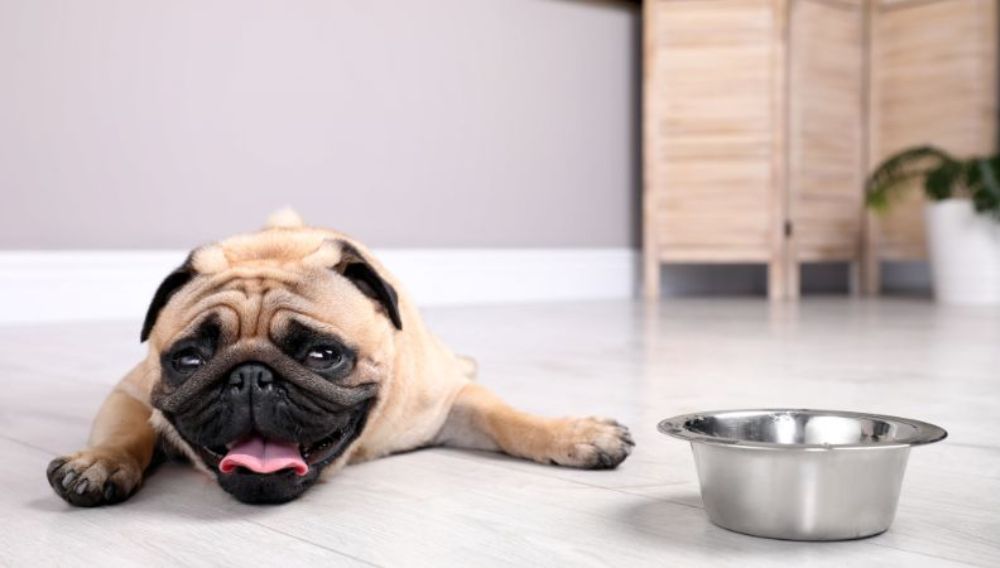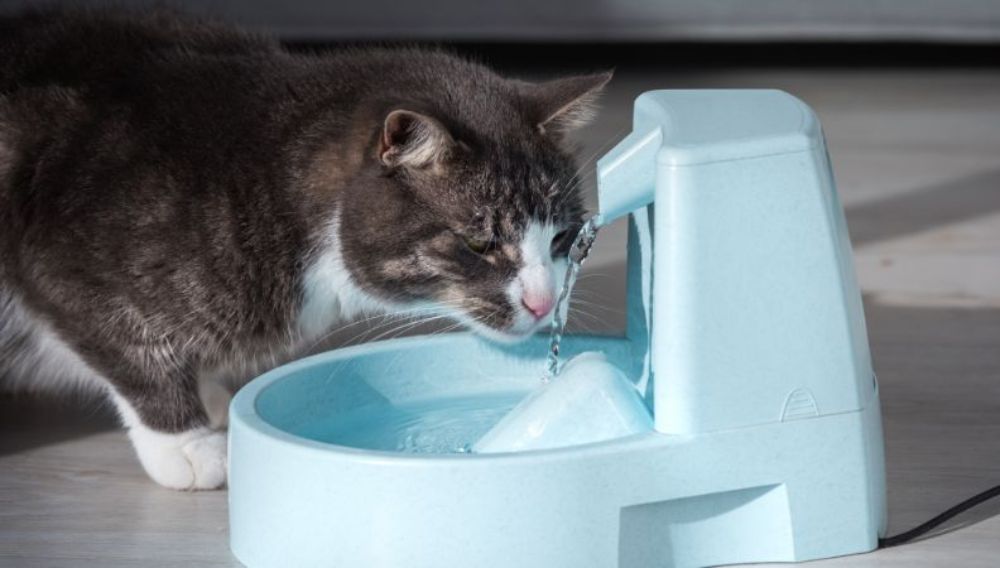Dogs, cats and rabbits sometimes don't drink enough at the best of times. No matter how many times your offer it, they won't touch an ounce of water unless they want to. Normally, they can be good at taking care of themselves, but when it comes to hot weather, they can be at risk of becoming dehydrated.
Very young pets, old pets and those in poor health are especially prone to dehydration that can lead to organ failure and death. Our expert friends at Vetstream have put this guide together to will help you recognise the all-important tell-tale signs of dehydration in dogs, cats and rabbits. Plus how you can help your pet maintain the balance between water intake and water loss, and how to prevent dehydration.
Signs of Dehydration in Dogs

Dogs can become dehydrated if they don’t drink enough or stop drinking altogether. A dehydrated dog can also be the result of too much fluid being lost through lots of vomiting, diarrhoea or panting if the weather is very hot. Dogs can also suffer from dehydration if they’ve got an underlying health condition like kidney disease, diabetes or cancer. So, always seek advice from your vet if you notice any changes in your dog’s peeing or drinking habits.
Watch out for the following symptoms of dehydration in dogs:
- Dry nose and mouth
- Dry, sticky gums
- Sunken eyes
- Loss of skin elasticity (pinch their skin on the top of their head – it should spring back quickly to its original position on release, more slowly if mild dehydration and not at all if severe dehydration)
- Lethargy
- Weakness
- Dark urine
- Collapse
Dogs that eat wet food don’t need to drink as much water than those on a dry food diet. Dogs generally drink around 50 ml of water per day per kilo of body weight. This means an average Labrador weighing around 30kg for example would drink about 1.5 litres of water every day.
Signs of Dehydration in Cats

If you suspect your cat is dehydrated, look out for the following cat dehydration symptoms:
- Dry nose and mouth
- Rapid breathing
- Bright red/blue gums
- Disorientation
- Vomiting or diarrhoea
If your cat eats dry food and drinks only a small amount of water, watch out for dehydration, especially if they’re ill or there’s a heatwave. An adult cat weighing around 4kg should drink at least 200 ml of water each day.
Increased water intake can indicate your cat has a health condition like kidney disease, diabetes, cancer or hyperthyroidism. They could also have a fever or infection. Get your cat checked by your vet if you’re concerned. Your vet may run a packed cell volume test which can determine your cat’s dehydration status and give some intravenous fluid to rehydrate them if needed.
Signs of Dehydration in Rabbits

Determining if a rabbit is dehydrated can be tricky as they’re clever at hiding signs of pain or illness. Keep an eye out for any of the following symptoms that may indicate your bunny is dehydrated:
- Lethargic, floppy
- Sunken eyes
- Dry, sticky gums
- Increased breathing rate
- Loss of appetite
- Dark urine and dry faecal pellets
- Loss of skin elasticity - pinch the skin on the back of their neck; if it’s slow to return to its normal position, it means they’re dehydrated
Rabbits drink a lot of water! They need at least 50-150 ml of water per kilogram of body weight every day (about 10% of their body weight). Dehydration and loss of electrolytes can happen quickly so make sure they’ve always got access to water.
Dehydrated bunnies are at risk of kidney problems, GI stasis (reduced gut motility), urinary tract infections and heatstroke. Rabbits can deteriorate quickly, so call your vet if you think your bunny is dehydrated.
How to Keep Cats, Dogs and Rabbits Hydrated
Always make sure your pets have a constant supply of fresh clean drinking water! Place a selection of water bowls around your house and garden. Water fountains with free-flowing, fresh water can also entice your pet to drink more.
If your pet refuses to drink, tempt them by putting something tasty in their water – dogs love chicken broth (low-salt) while cats enjoy tuna water. Remember to wash the bowls out afterwards or they’ll become foul-smelling!
Dogs and cats may also love a pet-friendly ice-lolly. Dogs can have frozen lollies made with water and their favourite fruit, veg or meat broth. Cats enjoy tuna water lollies. Make sure your dog doesn’t bite the ice-lolly though as they could damage their teeth and be a choking hazard (similarly with ice-cubes).
Older cats can be reluctant to drink. Try giving them wet food rather than dry food to increase their water intake. Or add water to their dry food.
Rabbits should be given plenty of cool water in a water bottle and a bowl. Bunnies may find water tastes better when flavoured with some coriander leaves, some carrot juice or their favourite fruit. Adding more leafy greens, cucumber or melon to your rabbit’s diet can also help to provide extra water.
Take lots of water with you if you plan to go on car journeys or long walks with your dog. And never leave them in the car as heatstroke can result very quickly.
Dehydrated pets may have low blood electrolyte levels which can weaken and damage their muscles. It can also affect nerve activity and the transport of nutrients. If severe, dehydration can lead to vital organs shutting down, so always seek veterinary advice. An electrolyte replacement fluid may be given intravenously at the vets, so your pet hydrates back to their normal level of fluids.
Top Tips for Keeping Your Pets Cool in Summer
Provide lots of shade outdoors for your pets or keep them indoors when very hot. The room should be well-ventilated with shade. Keep curtains and blinds shut and use fans (or air-conditioning) to keep temperatures down. If you have a conservatory, keep this out of bounds as it will get too hot for your pet in summer.
Cats generally stay less active to keep themselves cool in summer! But, if possible, keep your cat inside on hot days. You can then follow the handy tips above for keeping cats cool in summer.
Keeping dogs cool in summer is important, especially when out for a walk. Avoid the heat of the day and walk them early in the morning or late evening when it’s cooler. Always take water with you and give your dog small amounts to drink during your walk. During vigorous exercise they'll need extra water to avoid dog dehydration.
Rabbits don’t tolerate heat very well, so keeping rabbits cool in summer is essential. Hutches should be placed where there’s shade all day long. Put a ceramic or slate tile inside to provide a cool place for bunnies to lie on. Damp towels, ice packs and frozen water bottles can also be used.
Allow your rabbit access to their run as it’s likely to be cooler than their hutch. Runs must have constant shade throughout the day. The main way rabbits lose heat is through their ears. To lower their temperature, you can gently dampen their ears.
It’s best to act fast if you spot any signs of dehydration in your pet. If you’re worried that your pet has become dehydrated and has stopped drinking, contact your vet as soon as you can. Dehydration can be life-threatening and prompt treatment is needed for your pet to make a good recovery.
Everypaw Pet Insurance
Everypaw's Pet Insurance comes with 24/7 unlimited access to vets and vet nurses to help your pet's health, care, nutrition and behaviour. So you can rest assured that they'll be well looked after, whoever your new family member is! Get a quote today!
Content provided from Vetstream's Vetlexicon Canis – www.vetlexicon.com/treat/canis AND Felis - www.vetlexicon.com/felis AND Lapis - www.vetlexicon.com/treat/lapis
Vetlexicon is the world’s largest peer-reviewed online clinical reference source. All our content is written and peer-reviewed by over 1,000 of the world’s leading veterinarians, ensuring relevance, accuracy and quality.
- Vetstream Ltd, Kate Murphy, Poppy Gant (online) Heat stroke. In: Vetlexicon Canis. Vetstream Ltd, UK. Website: https://www.vetlexicon.com/treat/canis/client-information/heat-stroke
- Vetstream Ltd, Kate Murphy, Poppy Gant (online) Heat stroke. In: Vetlexicon Felis. Vetstream Ltd, UK. Website: https://www.vetlexicon.com/felis/critical-care/client-factsheets/heat-stroke/
- Thompson L, Flecknell P & Meredith A (online) Heat stroke. In: Vetlexicon Lapis. Vetstream Ltd, UK. Website: https://www.vetlexicon.com/treat/lapis/freeform/heat-stroke
- Vetstream Ltd & Claire Speight (online) Summer safety. In: Vetlexicon Lapis. Vetstream Ltd, UK. Website: https://www.vetlexicon.com/treat/lapis/client-information/summer-safety
- Claire Speight & Caroline Blake (online) Fluid therapy. In: Vetlexicon Lapis. Vetstream Ltd, UK. Website: https://www.vetlexicon.com/treat/lapis/client-information/fluid-therapy